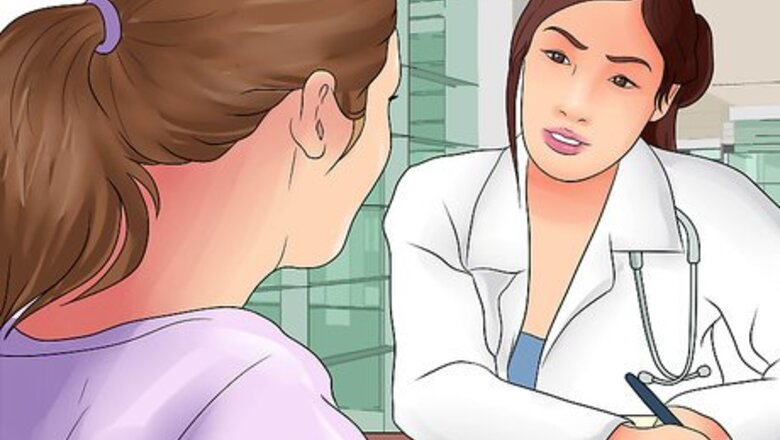
views
Managing Your Bulging Disc with Medical Help
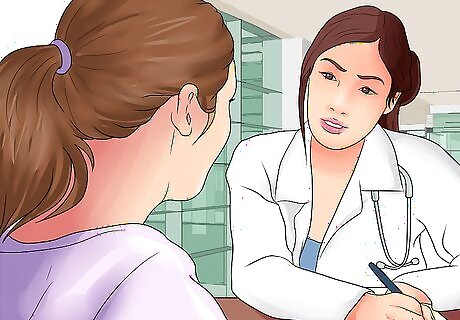
Stay in close contact with your doctor. If you know you have a bulging disc, then you probably have had diagnostic tests, like an MRI. Your doctor is a valuable and key resource for you during this difficult time. He or she will help coordinate your care with other disciplines, such as physical therapy or chiropractic, prescribe medications if they are needed, and stay on top of your condition to be certain a medical procedure is not necessary.
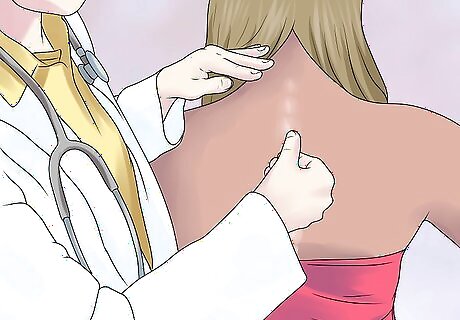
Participate in physical therapy. Your doctor will likely recommend physical therapy sessions to help relieve the pressure on the bulging disc, help the nerves in the area to recover, and reduce your pain. Physical therapy can make a big difference in relieving your symptoms, improving strength in your core muscles, increasing flexibility, and avoiding further injury and pain. The therapist will teach you important exercises that you can continue at home.
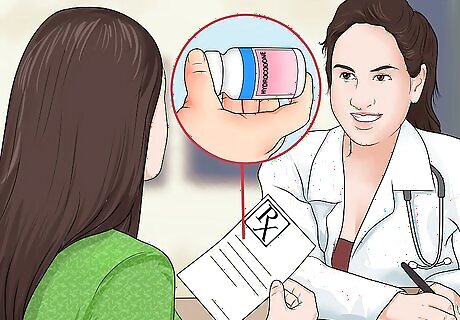
Take prescription medications for pain, inflammation, and muscle relaxation. Many people may have disc issues without pain. But in some cases, the pain experienced with a bulging disc can be severe. Your doctor can provide prescriptions for pain medications, for short-term use, that can help to provide some relief. Just be sure to closely follow your doctor's instructions for dosage and other considerations, like whether to take the medication with a meal. Examples of medications that may be prescribed include opiate pain relievers such as hydrocodone or oxycodone, pain patches such as lidocaine or fentanyl, prescription strength anti-inflammatory agents, such as high dose ibuprofen, and muscle relaxers such as cyclobenzaprine or Metaxalone.
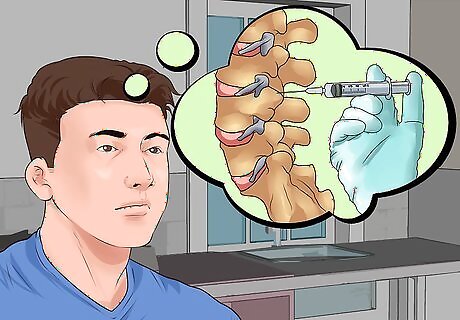
Consider injections. If the symptoms are slow to respond and the pain is severe, you may want to consider injections to the site. The most common type of injection for treating bulging discs is a spinal injection, also known as a nerve block injection or epidural. This type of injection uses steroid-like medication injected directly into the area to reduce inflammation and relieve the pain.
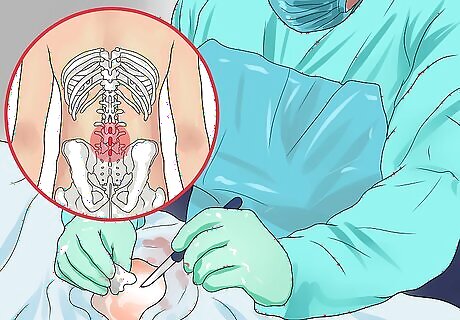
Consider minimally invasive surgical procedures. In some cases, surgical procedures may be the only option to treat the condition and provide pain relief. Minimally invasive procedures are successful at addressing the problems associated with bulging discs while reducing the risks involved with open back surgery. Commonly done procedures are called laminectomy, laminotomy, and microdiscectomy. Each procedure involves slightly differently methods to correct disc problems, depending on the location and extent of the damage.
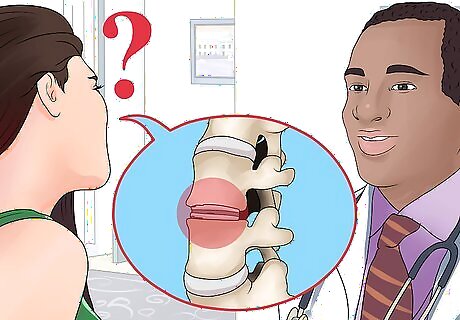
Ask your doctor about disk replacement surgery. In some cases, surgical procedures can effectively remove the damaged disc by performing a procedure called a discectomy, then inserting a synthetic disc in its place. This type of surgery restores the height of the space between the vertebrae, and allows for normal movements.
Managing Your Bulging Disc at Home
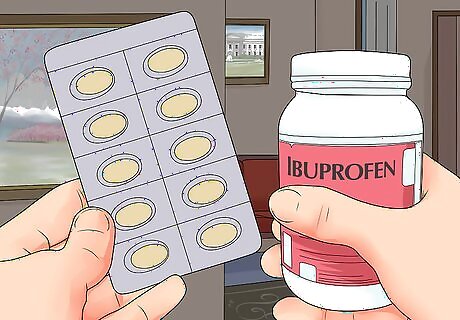
Take over-the-counter medications. Talk to your doctor before adding any new medications to your existing regimen. Commonly recommended over-the-counter drugs include anti-inflammatories like ibuprofen, naproxen, and aspirin. Acetaminophen is helpful in providing added relief for the pain. Take the medications exactly as prescribed and talk to your doctor if you experience any side effects. Do not continue to take over-the-counter medications with prescription strength medications, unless your doctor specifically tells you to do so. Combining over-the-counter drugs with prescribed pain medications, anti-inflammatory agents, and muscle relaxers can be dangerous.
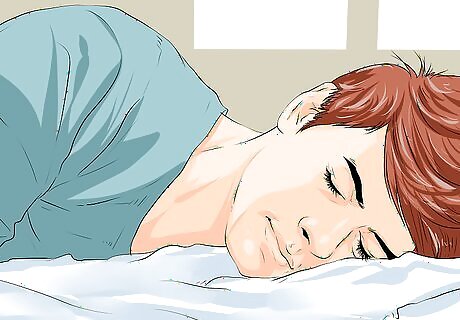
Rest. Allow your body the time it needs to heal by getting enough rest while you pursue proper care. Appropriate care will likely include resting in short segments, like 30 minutes at a time, then walking or doing some light movements as recommended by your doctor and physical therapist. Avoid activities that can aggravate your condition, especially bending over and lifting and any twisting type of movement. Move slowly, and stop any activity if you feel pain. Pursue physical therapy that will include specific types of exercise to improve your condition.
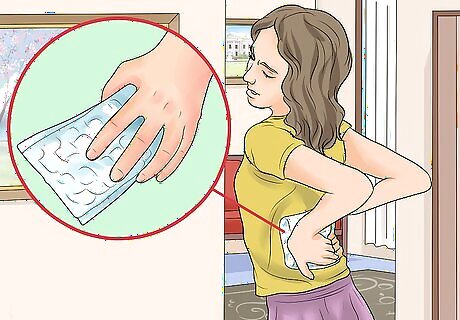
Apply ice. Initially the painful area will likely be swollen and inflamed. Applying ice, instead of heat, can help to reduce swelling and inflammation, and relieve the pain. Apply ice to the area for five minutes every hour. By the third or fourth hour, you should notice some relief. Continue to use the ice on the area of the bulging disc first, then you may also apply ice to any other affected areas, like painful nerves down your leg. Follow your doctor or therapist’s advice on how long, and how often, to continue the ice applications.
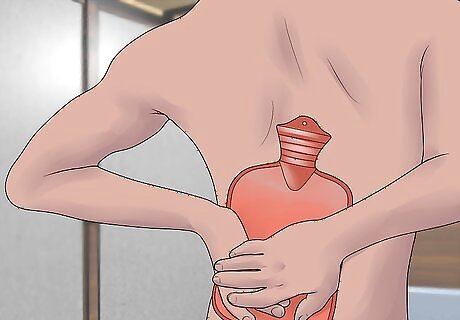
Apply heat. Using applications of heat can be soothing to tight and sore muscles, and improve blood flow to the area. Improved blood flow means more oxygen to the muscles, and nutrients to the damaged disc. Talk to your doctor or physical therapist to determine the proper rotation of hot and cold that is best suited to your condition.
Preventing Further Problems
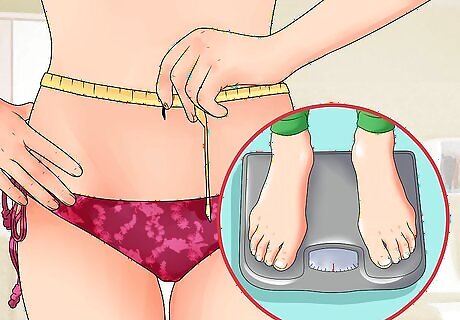
Maintain a healthy weight. Being overweight naturally puts more stress on each disc. While it may be difficult to lose weight, especially at a time when you are in pain, pursuing weight control measures can make a difference in managing your existing pain, and preventing further problems

Take calcium and vitamin D supplements. Your spine needs enough calcium and vitamin D every day to stay strong and avoid developing osteoporosis. Most adults do not get enough from their diet. Ask your doctor about the amount of calcium and vitamin D you should consume each day, in addition to your regular diet. Natural sources for calcium and vitamin D include dairy products, green, leafy vegetables, and fortified orange juice. Your body also absorbs vitamin D from being exposed to natural sunlight.
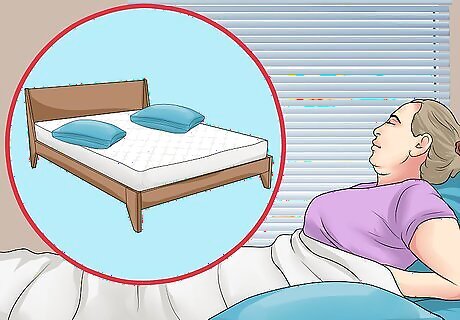
Sleep on a firm mattress. Avoid sleeping on your stomach, as this puts added pressure on the discs in your back. Try sleeping on a firm mattress, and on your side, with pillows arranged for added support if helpful.
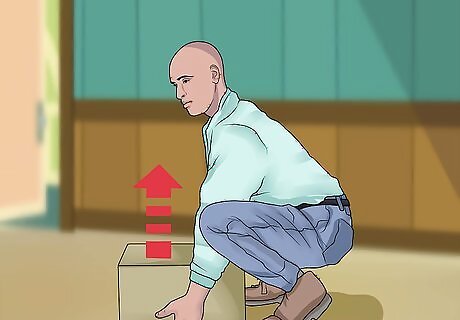
Use proper techniques when lifting. Avoid lifting anything heavy if at all possible. If you must lift something, bend your knees and squat, then use your legs to lift the weight. It’s also important to avoid any lifting or repetitive twisting motions first thing in the morning.
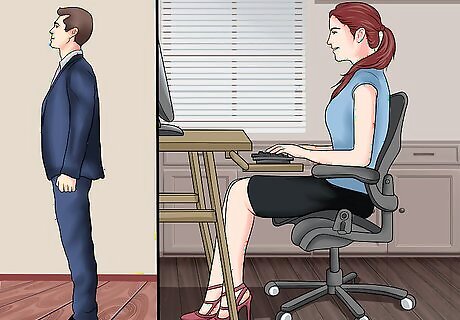
Pay attention to your posture. Proper standing and sitting positions include a straight, upright, position with your shoulders back. Engage abdominal muscles to provide support for your back, and maintain your lower back in a flat or slightly arched position To improve your balance, stand in a doorway, raise one leg high, bend your raised knee so your thigh is parallel to the floor. Hold that position for 20 seconds, then repeat with the other leg. Hold onto the wall or doorway if you need, but eventually you will be able to maintain the position without additional support. Improve your overall alignment by standing one foot length away from a wall, then lean back until your buttocks and your back are against the wall. Keeping your head level, push it back until the back of your head touches the wall. Most people find they must tilt their chin up to get their head to touch the wall, which indicates poor posture. Push your head back as far as you can while keeping it level. Hold this position for 20 seconds. Eventually, your head should reach the wall, without the unwanted tilt.
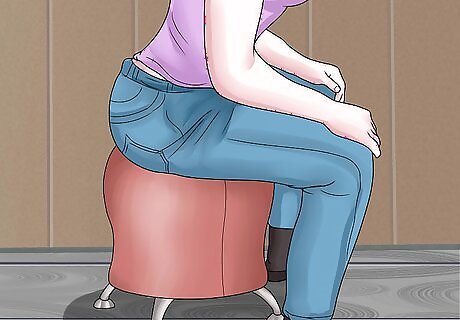
Choose a chair that provides support. Regular seating causes a pelvic tilt that puts extra pressure on your discs. Sitting in this position for extended periods can contribute to back problems, like bulging discs. Many experts are now recommending seating options called “active chairs”. An active chair is designed to help you maintain spinal integrity, engage your muscles, and work on your posture, all while you are seated. Several types of active chairs are available. A few examples include a Zenergy Ball Chair, Swopper Stool, Wobble Stool, Rockin’ Roller Desk Chair, and Humanscale Freedom Saddle Seat. Although these chairs may be beneficial, keep in mind that it is also important to get up and move around now and then. Try setting a timer to remind yourself to get up for a couple of minutes for every hour that you sit.
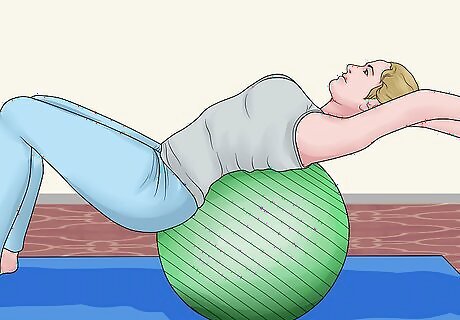
Bounce on a therapy ball. Talk to your doctor or physical therapist to be sure this is safe for your condition. A therapy ball is similar to the large balls you may see in a gym or a physical therapy clinic. By softly bouncing for about five minutes each day, you improve the blood flow to the discs, bringing added nutrients and oxygen to the area. This provides for reduced inflammation, pain relief, and may help to prevent further problems.
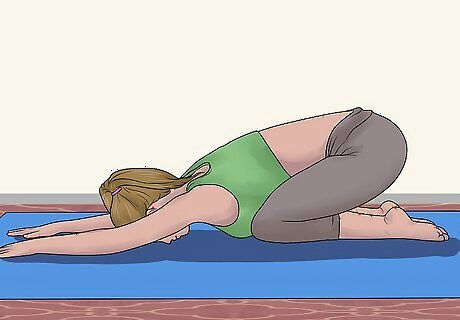
Exercise safely and regularly. Specific types of exercise that target problems with back pain include flexion, extension, stretching, and aerobic exercise. Talk to your doctor or physical therapist about developing an exercise routine that is safe, and helpful, for your condition. Keep in mind that everyone is different. Some people may respond best to back flexion exercises, while other people may respond best to back extension exercises. If you find that your back pain increases during any of these exercises, stop doing them immediately and see your doctor or physical therapist. Find some exercise that you like to do and be consistent with it.
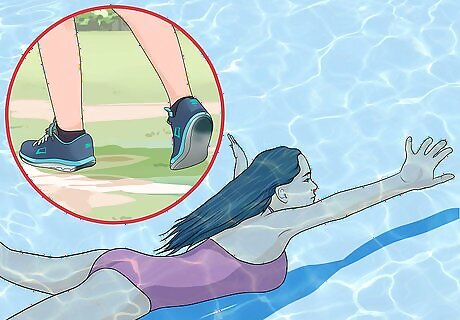
Engage in low-impact exercises. Examples of low-impact exercise includes walking, swimming, cycling on a recumbent bike, meditation, or modified yoga. Depending on the position of the bulging disc along your spine, your age, weight, mobility, and other medical conditions you may have, your doctor and physical therapist are the experts on designing an exercise program that is suited for you.
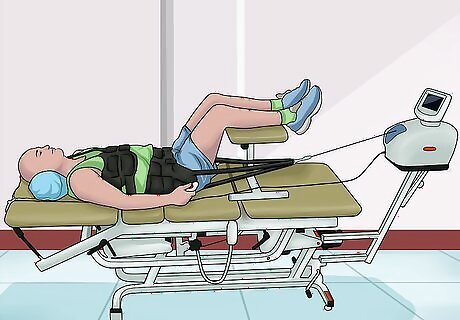
Try decompression therapy or traction. Manual or electric traction can be an excellent way to keep your discs healthy. Traction can help to reduce pressure on a disc, which is beneficial because that allows more nutrients to enter the disc. You can receive traction therapy at your chiropractor's office or physical therapy office, or use a home inverted traction unit. An economical choice for home therapy is a simple back stretcher with three levels of adjustment.
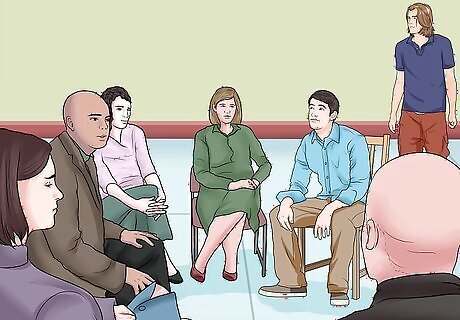
Seek out a support system. Chronic pain can lead to anxiety, added stress, and depression, all of which interfere with your body's ability to heal. Take measures to provide support as you go through this difficult time. Find out about chronic pain support groups in your area. Keep in mind that this may be helpful to you, but you may also provide much needed support for others.
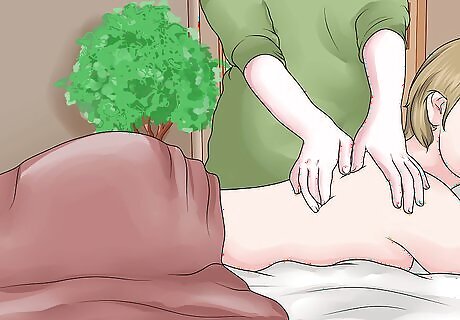
Develop a stress-relief routine. Try activities such as massage, acupuncture, baths, walking, and meditation, to help you handle the physical and mental manifestations of dealing with both acute and chronic pain. Mindful meditation may produce improvements in chronic back pain that are similar to conventional treatments.
Knowing When to Seek Medical Attention
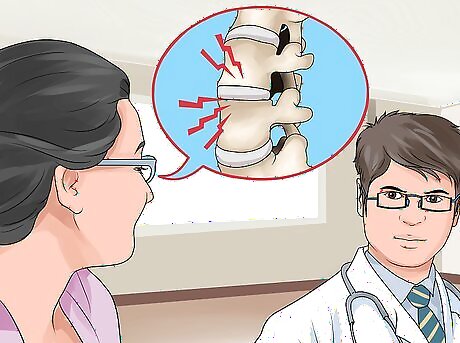
Seek medical attention if the pain is disabling. Many people experience severe pain with a bulging disc. If your pain prevents you from performing routine daily activities, consult your doctor as soon as possible for treatment options
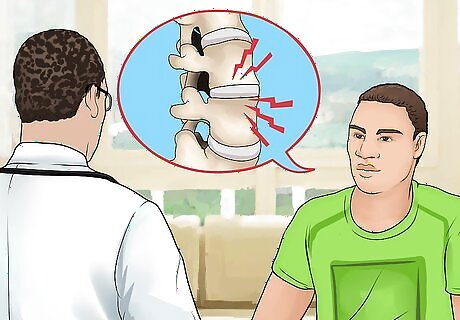
Get in touch with your doctor if your pain is severe and persistent. If your pain is severe, continues at that level for more than 7 days, gets even worse, or improves a little but persists for more than 3 weeks, then medical attention is warranted.
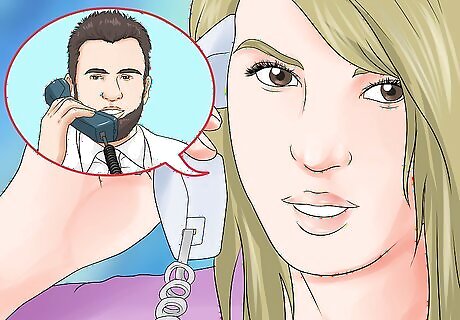
Contact your doctor immediately if your symptoms change. Your condition may be progressing. This is evidenced by a change in your symptoms that may include new areas of pain or numbness, which indicate involvement of additional nerve roots located along the spine and near the damaged disc.
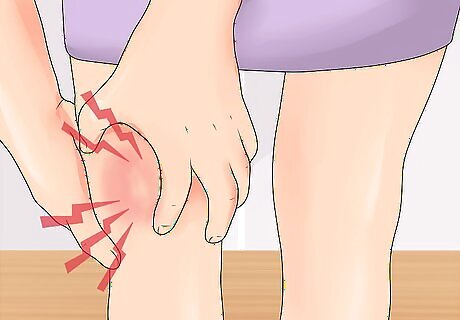
Watch for new symptoms in your legs. Notify your doctor as soon as possible if you start having symptoms in your extremities, especially your legs. If you notice sudden or ongoing feelings of weakness, a feeling of numbness, tingling, or shooting pains in your legs when you cough, sneeze, or strain, contact your doctor as soon as possible.
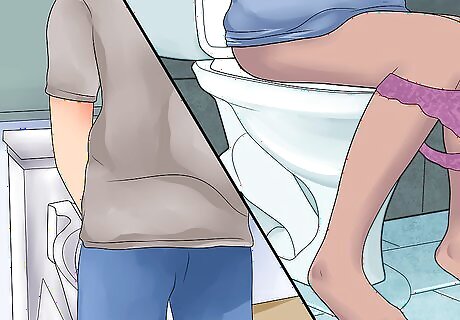
Pay attention to your bladder and bowel function. In some cases, the nerves involved with the bulging disc can cause changes in your bowel and bladder function. Contact your doctor immediately if this occurs. Back pain that occurs when you urinate, severe pain and muscle spasms deep in your back, or loss of control of your bladder or bowel function warrants immediate medical attention.




















Comments
0 comment